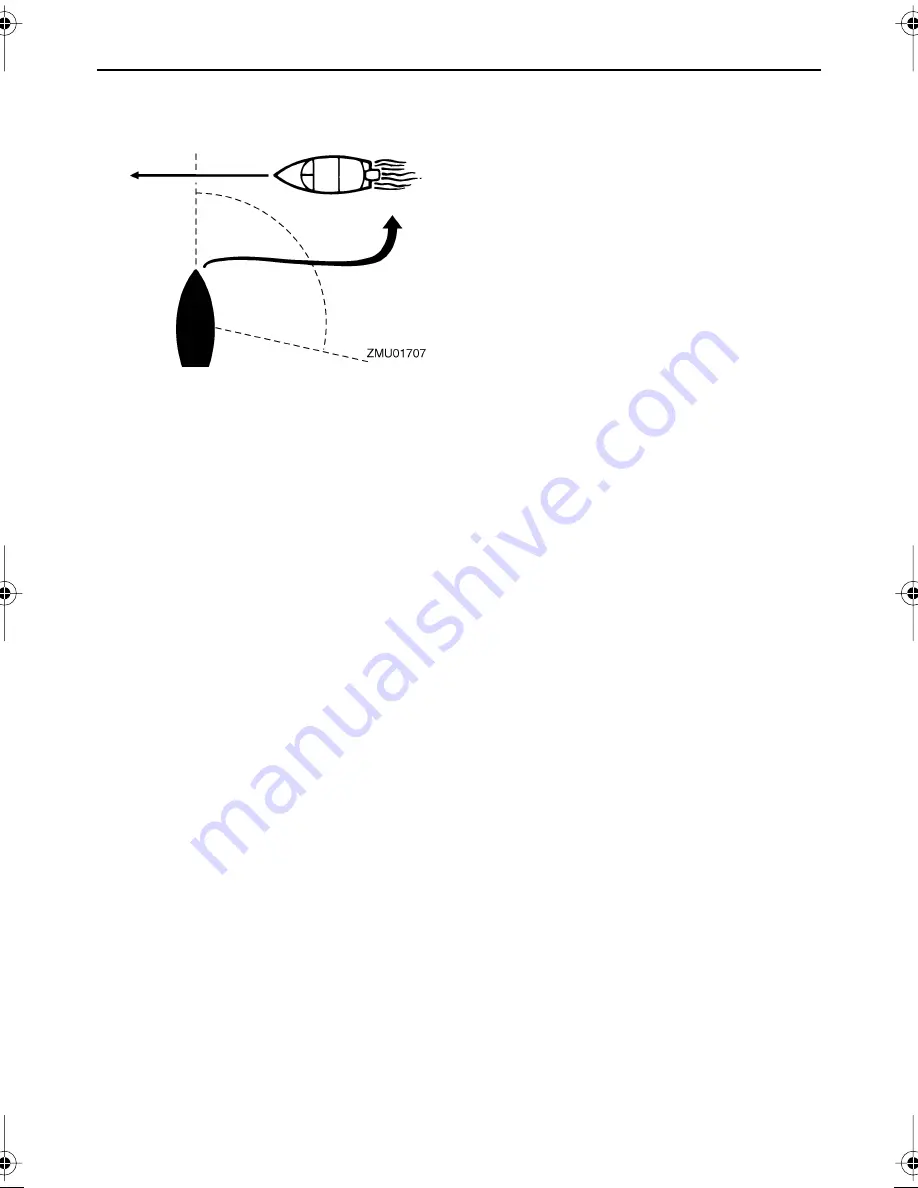
General information
6
tion, provided the other vessel gives you the
right-of-way as it should.
Overtaking
If you are passing another vessel, you are
the “Give-Way” vessel. This means that the
other vessel is expected to maintain its
course and speed. You must stay out of its
way until you are clear of it. Likewise, if an-
other vessel is passing you, you should
maintain your speed and direction so that the
other vessel can steer itself around you.
EMU25530
Other special situations
There are three other rules you should be
aware of when driving your boat around oth-
er vessels.
Narrow channels and bends
When navigating in narrow channels, you
should keep to the right when it is safe and
practical to do so. If the operator of a power-
driven vessel is preparing to go around a
bend that may obstruct the view of other wa-
ter vessels, the operator should sound a pro-
longed blast on the whistle (4 to 6 seconds).
If another vessel is around the bend, it too
should sound the whistle. Even if no reply is
heard, however, the vessel should still pro-
ceed around the bend with caution. If you
navigate such waters with your boat, you will
need to carry a portable air horn, available
from local marine supply stores.
Fishing vessel right-of-way
All vessels which are fishing with nets, lines
or trawls are considered to be “fishing ves-
sels” under the International Rules. Vessels
with trolling lines are not considered fishing
vessels. Fishing vessels have the right-of-
way regardless of position. Fishing vessels
cannot, however, impede the passage of
other vessels in narrow channels.
Sailing vessel right-of-way
Sailing vessels should normally be given the
right-of-way. The exceptions to this are:
1.
When the sailing vessel is overtaking
the power-driven vessel, the power-driv-
en vessel has the right-of-way.
2.
Sailing vessels should keep clear of any
fishing vessel.
3.
In a narrow channel, a sailing vessel
should not hamper the safe passage of
a power-driven vessel which can navi-
gate only in such a channel.
Reading buoys and other markers
The waters of the United states are marked
for safe navigation by the lateral system of
buoyage. Simply put, buoys and markers
have an arrangement of shapes, colors,
numbers and lights to show which side of the
buoy a boater should pass on when navigat-
ing in a particular direction. The markings on
these buoys are oriented from the perspec-
tive of being entered from seaward (the boat-
er is going towards the port). This means that
red buoys are passed on the starboard
(right) side when proceeding from open wa-
ter into port, and black buoys are to port (left)
side. When navigating out of port, your posi-
tion with respect to the buoys should be re-
versed; red buoys should be to port and
black buoys to starboard.
Many bodies of water used by boaters are
entirely within the boundaries of a particular
✩✩✬✤✫✲✣ ✩
Summary of Contents for VX200D
Page 1: ...VX200D OWNER S MANUAL 66K 28199 18 U S A Edition LIT 18626 05 93 ...
Page 2: ...EMU25060 ZMU01690 Read this owner s manual carefully before operating your outboard motor ...
Page 63: ...Maintenance 58 ZMU01943 ...
Page 73: ...68 Consumer information EMU29811 Important warranty information for U S A and Canada ...
Page 74: ...Consumer information 69 ...
Page 76: ...Consumer information 71 ...
Page 77: ...Consumer information 72 ...
Page 79: ...Printed in Japan April 2004 0 2 1 Printed on recycled paper ...
Page 81: ...PLACE POSTAGE HERE ATTN WARRANTY DEPARTMENT Warranty card 2 27 02 11 47 AM Page 2 ...












































